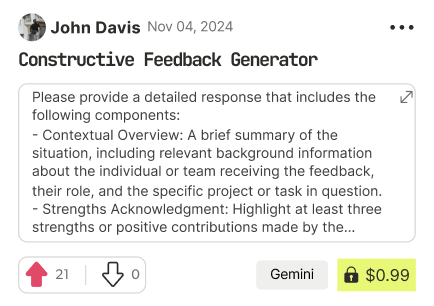prompt mine App
Find, Create & Share AI Magic
Genre Evolution: A Deep Dive
The music genre I have chosen to detail is Hip Hop.
Hip Hop's journey from humble block parties in the Bronx to a global cultural phenomenon is a truly remarkable story, deeply intertwined with social shifts and technological innovation.
THE INCEPTION AND EARLY DAYS:
Hip Hop began in the early 1970s in the South Bronx, New York City, as an artistic expression of African American and Latino youth. Facing economic hardship and social neglect, young people found solace and community in block parties. DJs like DJ Kool Herc, Afrika Bambaataa, and Grandmaster Flash pioneered the use of two turntables to extend the "break" sections of funk, soul, and disco records, which were the most danceable parts. This technological innovation of manipulating vinyl records was foundational. Soon, MCs emerged, originally to hype up the crowd and introduce the DJ, but quickly evolved into rhythmic poets, or rappers, laying down rhymes over the breaks.
THE 1980S - COMMERCIAL BREAKTHROUGH AND DIVERSIFICATION:
By the early 1980s, the raw energy of Hip Hop began to be captured on vinyl. The Sugarhill Gang's "Rapper's Delight" (1979) was the first mainstream Hip Hop hit, introducing the sound to a wider audience. This period saw a major cultural shift as Hip Hop moved from local parties to recording studios, initially on independent labels.
KEY ARTIST 1: Grandmaster Flash and The Furious Five.
Their track "The Message" (1982) was a pivotal moment. While often released as a single, it was included on the album THE MESSAGE. This song moved Hip Hop beyond party rhymes to address grim realities of inner-city life, showcasing Hip Hop's potential as a voice for social commentary and raising awareness of urban decay and poverty. This was a significant social movement within the music itself.
Technological advancements like more sophisticated drum machines (the Roland TR-808 became iconic) and early samplers allowed for richer, more complex productions. This led to a more polished sound.
KEY ARTIST 2: Run-DMC.
Their album RAISING HELL (1986) was a game-changer. It was the first Hip Hop album to go platinum, showcasing a fusion of rock and rap (most notably with Aerosmith on "Walk This Way") that broadened the audience demographics significantly. They brought an accessible, hard-hitting style that appealed to rock fans and solidified Hip Hop's place on MTV, a crucial industry trend that gave Hip Hop unprecedented visual exposure.
KEY ARTIST 3: Public Enemy.
Their album IT TAKES A NATION OF MILLIONS TO HOLD US BACK (1988) redefined the genre's political and social consciousness. With Chuck D's powerful lyrics and Flavor Flav's energetic ad-libs, backed by The Bomb Squad's dense, samples-heavy production, they tackled racism, media manipulation, and political inaction head-on. This resonated with the civil rights movement's ongoing legacy and a generation frustrated with systemic inequalities. The increasing availability and affordability of samplers fueled this creative explosion.
THE 1990S - THE GOLDEN ERA AND MAINSTREAM DOMINANCE:
The 1990s are often called Hip Hop's Golden Era. It saw incredible diversification and commercial explosion. The West Coast, led by artists like Dr. Dre, developed G-funk, a smoother, funk-infused sound. The East Coast continued to innovate with artists like Nas, The Notorious B.I.G., and Wu-Tang Clan. Audience demographics expanded rapidly, becoming truly global.
KEY ARTIST 4: Tupac Shakur.
His album ALL EYEZ ON ME (1996) showcased his unparalleled storytelling and charisma. Though his life was tragically cut short, Tupac became an icon, embodying the struggles and aspirations of a generation. His music often touched on gang culture, racial injustice, and personal introspection, reflecting significant social tensions of the time. The increasing sales of CDs further boosted artist revenues and album importance.
The decade also saw the rise of major record label interest, leading to massive recording contracts and a more consolidated industry trend. However, it also led to highly publicized rivalries, particularly the East Coast-West Coast Hip Hop rivalry, which had tragic consequences.
THE 2000S TO PRESENT - GLOBAL REACH AND DIGITAL TRANSFORMATION:
The 2000s saw Hip Hop become the dominant popular music genre worldwide. Artists like Jay-Z, Eminem, and 50 Cent achieved superstar status. The South, particularly Atlanta, became a new epicenter with artists like OutKast and Lil Wayne pushing sonic boundaries.
The most significant technological advancement impacting this era was the internet. Digital downloads (legal and illegal through platforms like Napster) drastically changed how music was consumed and distributed. This challenged traditional industry trends based on physical album sales. Social media platforms began to emerge, giving artists direct access to fans.
KEY ARTIST 5: Kendrick Lamar.
His album TO PIMP A BUTTERFLY (2015) is a masterpiece of modern Hip Hop. It's a complex, jazz-infused exploration of race, identity, and the pressures of fame, resonating strongly with movements like Black Lives Matter. His work represents a return to lyrical depth and conceptual album-making, proving that Hip Hop can be both commercially successful and artistically profound.
The 2010s to today have been defined by the rise of streaming services (Spotify, Apple Music) and social media platforms (YouTube, TikTok) which have completely reshaped the industry. This has democratized music distribution but also shifted the focus from album sales to streaming numbers and viral moments.
CURRENT STATE OF THE GENRE:
Hip Hop is the most consumed genre globally. It continues to evolve at a rapid pace, with diverse sub-categories:
TRAP MUSIC: Characterized by heavy 808 bass, hi-hats, and often dark, minimalist production. It's currently one of the most popular subgenres. Prominent artists include Travis Scott, Migos, and DaBaby.
DRILL MUSIC: A grittier, darker offshoot of trap, often originating from Chicago and later globalized, known for its raw lyrical content.
EMO RAP: Blending Hip Hop with emo music's introspective lyrics and melodic sensibilities. Artists like Juice WRLD (posthumously) and Lil Uzi Vert have been influential.
CONSCIOUS HIP HOP: Continues the tradition of social and political commentary. Artists like J. Cole and Rapsody are prominent.
LO-FI HIP HOP: Often instrumental and chill, popular for background music and studying, gaining traction on streaming platforms.
Prominent artists today include Drake, Cardi B, Travis Scott, J. Cole, Megan Thee Stallion, Lil Baby, and Tyler The Creator, who all continue to push the genre's boundaries both sonically and culturally. Hip Hop remains a powerful voice for social commentary, a commercial powerhouse, and a constantly innovating art form.

Find Powerful AI Prompts
Discover, create, and customize prompts with different models, from ChatGPT to Gemini in seconds

Simple Yet Powerful
Start with an idea and use expert prompts to bring your vision to life!
